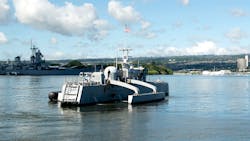Researchers eye trains of wave-resistant medium-size unmanned ships to move military across the oceans
ARLINGTON, Va. – U.S. military researchers are trying to make it easier for military forces to cross the world's oceans by using a system of connected unmanned surface vessels (USVs) that would act as trains across the seas.
Officials of the U.S. Defense Advanced Research Projects Agency (DARPA) in Arlington, Va., issued a broad agency announcement (HR001120S0010) on Monday for the Sea Train project.
This program seeks to enable extended transoceanic transit and long-range naval operations by capitalizing on the efficiencies of a system of wave-resistant connected vessels using a distributed fleet of tactical unmanned ships.
The idea is to deploy lines of medium-sized unmanned ships that could help reduce the forces of waves. Sea trains could be formed by physically connecting vessels loosely, or by sailing vessels in formations.
Related: Coast Guard looks for unmanned ocean vehicles to hunt smugglers, poachers, and icebergs
Sea Train has two technical areas: an integrated design of unmanned vessels; and a control and monitoring architecture to make the most of efficiencies.
Leaders of the U.S. Navy and Marine Corps are trying to shift from centralized operations on a few large manned surface ships to a distributed fleet of relatively small and low-risk vessels for safe ocean transit.
A key element of this operational shift is the growing application of unmanned surface ships for surveillance, logistics, electronic warfare (EW), expeditionary warfare, and offensive operations.
A key limitation of unmanned ships is their limited ranges because of the effects of large ocean waves on medium-sized vessels. At-sea refueling, heavy-lift ships, strategic airlift, and increased overall vessel size all are solutions to this limitation, but are vulnerable to enemy submarines, surface warships, and combat aircraft.
Related: Unmanned submarines seen as key to dominating the world’s oceans
The first technical area of the Sea Train project involves developing an integrated design composed of a hull form, hull connector, propulsion, and gap mitigation between the vessels. The second technical area involves developing a control architecture to monitor environmental conditions; handle multi-vessel alignment, spacing, and structural loads.
The project has three potential approaches: a connected sea train; a connectorless sea train; and a formation sea train.
The connected sea train has a physical connection between four or more vessels during transit to form a long parallel mid-body for the vessel to decrease the vulnerability to waves, while enabling the vessels to disconnected from time to time to conduct tactical missions.
The connectorless sea train uses compressive forces to keep four or more vessels together in a long parallel mid-body for the vessel to decrease the vulnerability to waves, while enabling the vessels to disconnect to conduct tactical missions.
The formation sea train involves four or more vessels moving together in groups formed closely front and back, and side to side, to exploit wave interference between the vessels.
DARPA researchers discourage the use of drag-reduction technologies, such as polymer injection; energy creation, harvesting, or storage technologies; systems that require fuels other than marine diesel systems that require human intervention during connecting and disconnecting; nuclear power and propulsion; and systems that experiment using live animals.
The Sea Train project seeks to design a hull that makes the most of drag reduction; control surfaces for maneuvering and seakeeping; ways to connect to several medium-size unmanned ships; and low-drag propulsion.
The Sea Train's control architecture should have real-time networked computers able to share information among vessels -- especially by linking weather forecasts with path planning and seakeeping; and ways to monitor vessel performance.
Related: The new world of counter-drone technology
Sea Train sensors should include techniques that perceive sea conditions for path planning and route optimization identify vessel spacing and orientation identify structural loads; handle vessel autonomy; and decision algorithms for propulsion and fuel consumption.
Companies interested should submit proposals no later than 20 Feb. 2020 to the DARPA BAA Website at https://baa.darpa.mil.
Email questions or concerns to DARPA at [email protected]. More information is online at https://beta.sam.gov/opp/cc8157fcd8e845f3b5d883fd517172c0/view.

John Keller | Editor-in-Chief
John Keller is the Editor-in-Chief, Military & Aerospace Electronics Magazine--provides extensive coverage and analysis of enabling electronics and optoelectronic technologies in military, space and commercial aviation applications. John has been a member of the Military & Aerospace Electronics staff since 1989 and chief editor since 1995.

